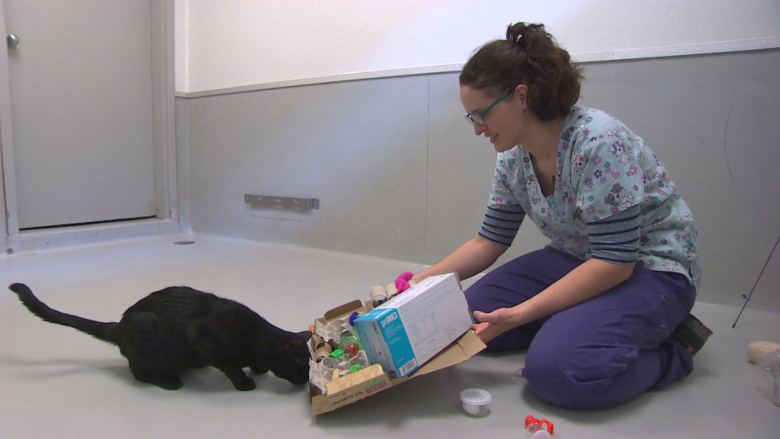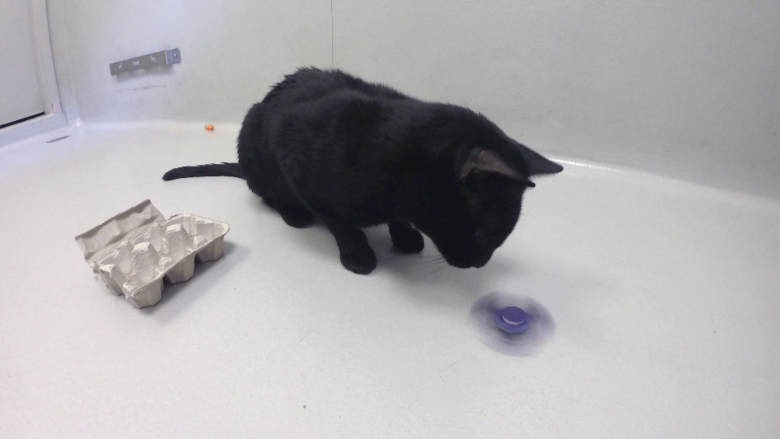Don't touch that cat: Humane Society program focuses on felines' minds, not their cuddles
The Winnipeg Humane Society has scratched out its cat cuddling program, but don't feel bad for the felines.
The animal shelter has started retraining its team of 150 volunteer cuddlers in an effort to broaden the range of activities and stimulation they offer to the cats in their care.
Now in addition to scratches behind the ears, each cat gets a little box filled with toys like fidget spinners, dangling wands, and laser pointers to get its attention and give it a chance to engage in a wider range of normal cat behaviours.
"A cat that lives in the wild, they would have to hunt for their food, they'd have to stalk and hunt the mice, and all of their senses would be flooded out in the wild," said Catherine McMillan, the society's manager of behaviour and intake. "But unfortunately, in a sterile environment, they don't get those needs met."
McMillan designed the new program after becoming concerned the old one wasn't doing enough to help the cats. By focusing exclusively on physical contact with the cats, the program didn't stimulate the cats' other senses and could be stressful for some cats.
"Even though, yes, all people like to cuddle cats, not all cats like to be cuddled. And so this enrichment program is designed to interact with the cats in a way that the cat would appreciate as opposed to humans appreciating."
Improving the mental health of the cats improves their physical well-being. The shelter can be a sterile environment, and cats get bored and stressed, making them more susceptible to infections, which makes them less active, leading to a vicious cycle, McMillan said.
Since the new program launched on Dec. 4 with a team of 65 newly trained volunteers, McMillan says volunteers have noticed a difference in even the shyest cats at the shelter.
"Once they're done with their volunteer session, they notice that all the cats are at the front of their cages, even the shy ones," she said. "They're no longer hiding because they learn that people don't always mean that they're going to be touched."
The new program has also benefited the volunteers, who feel like they are doing more for the cats in their care, McMillan said.
Volunteers had come forward with concerns about one cat in particular, a 13-year-old female named Pepitte, who after 290 days has been at the shelter longer than any other.
"And that's tough for the volunteers to see that this cat is sitting here and essentially, I hate to say it, rotting, because she's sitting here and nobody's coming for her," McMillan said. "So volunteers asked how they could help this cat and we have essentially given them the tools to say this is what we can do to enrich this cat."
Now Pepitte, who used to cower in the back of her cage whenever humans entered the room, has started to interact with the volunteers.
In addition to new toys, the shelter now has television sets with videos of small animals to entertain the cats. To stimulate their sense of hearing, the shelter plays audio recordings of birds, as well as classical music.
They also have pots that smell like prey, such as rabbits and pheasants.
Encouraging cats to break out of their shells and be more active doesn't just improve their well-being while they're in the shelter, it also improves their chances of being adopted, McMillan said.
When clients come into the shelter, volunteers can tell them how to best engage with the cat, leading to a better sense of connection between the client and the cat, she said.
WHS has completed one session of its six-week training course for the volunteers. McMillan says they have three more sessions planned to start in January, and hopes that by March, they will have the same number of volunteers in the new program that they had in the old.



